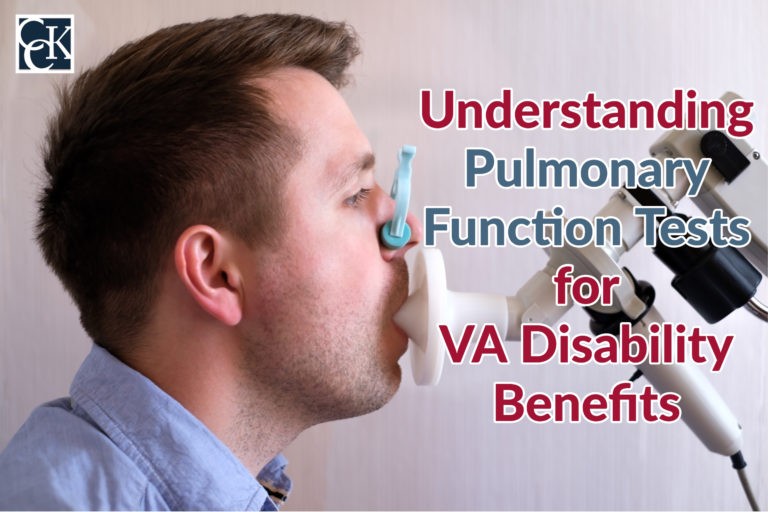Understanding Pulmonary Function Tests for VA Disability Benefits

CCK Law: Our Vital Role in Veterans Law
When assigning ratings for respiratory conditions, VA uses pulmonary function tests (PFTs) to determine how the veteran’s condition affects their respiratory system. As such, understanding how pulmonary function tests work and why they are a crucial aspect to all respiratory ratings is key. To learn more about the types of pulmonary function tests VA may require a veteran to undergo, continue reading.
Types of Respiratory Conditions
To understand the different types of respiratory conditions, it can be helpful to understand the two different types of lung disease: obstructive and restrictive.
Obstructive Lung Disease
If a person has obstructive lung disease, they typically have trouble exhaling air out of the lungs. With this condition, the airway has been narrowed or damage has been done to the lungs making it so a person exhales air very slowly. Even after exhaling, a person with obstructive lung disease may have an unusual amount of air in their lungs.
Obstructive lung disease can make it harder to breathe, especially during physical activity. As a person’s breathing rate increases, they have less time to exhale completely before needing to inhale again.
Some forms of obstructive disorders include:
- Asthma
- COPD, or Chronic Obstructive Pulmonary Disease
- Cystic Fibrosis
- Bronchiectasis
Restrictive Lung Disease
If a person has restrictive lung disease, it means that they usually cannot fill their lungs with air because the lungs are being restricted from expanding fully. It could be difficult for a person with restrictive lung disease to take a full breath.
Some forms of obstructive disorders include:
- Pulmonary fibrosis
- Interstitial lung disease
- Sarcoidosis
- Amyotrophic lateral sclerosis (ALS) or other neuromuscular diseases
- Asbestosis
- Sleep apnea

Pulmonary Function Tests for VA Disability Benefits
Pulmonary function tests (PFTs) designed to show how well the lungs are functioning. Specifically, they can measure lung volume, capacity, rates of flow, and gas exchange. In other words, a PFT test can determine how much air is being inhaled and exhaled, as well as how much carbon monoxide can enter the bloodstream during a specific time period.
When assessing a veteran’s respiratory condition, a VA doctor will perform a pulmonary function test to both diagnose a condition and determine the severity of the condition, especially over time. A PFT can also determine whether a veteran is experiencing an obstructive or restrictive disorder and which area of the lungs is being affected.
These tests can also measure three specific aspects of lung function:
- Spirometry
- Lung volumes
- Diffusion capacity in the lungs
How Should Veterans Prepare for Pulmonary Function Tests?
The doctor performing your PFT will usually provide you with the necessary information you need to prepare yourself for the test. They may advise you to:
- Stop taking certain medication prior to the test
- Stop smoking a certain number of hours prior to the test
- Not eat a heavy meal beforehand
Your weight and height may also be recorded during the test. If you have any questions about the tests, or how to prepare, it is best to discuss that with the doctor prior to the test.
How Will the Test Be Conducted?
PFTs can be conducted with two different methods, spirometry and plethysmography. VA uses spirometry measurements to determine a respiratory condition rating for the purpose of VA benefits.
Spirometry Tests
Spirometry tests are most common, due to the easy, quick nature they can be performed. Specifically, VA’s rating system is very dependent upon spirometry results when assigning a rating for a respiratory condition.
A spirometer is a device with a mouthpiece that is hooked up to a small electronic machine. There may also be a nose clip which is placed over the nose to prevent air from coming in the nose. During a spirometer test, the veteran will breathe into the mouthpiece. The veteran will then breathe in and exhale as hard as possible for six to ten seconds. The strength of the exhale will then be recorded.
The test will most likely be repeated a handful of times to ensure that the results are accurate.
A spirometry test can measure two key things:
- Forced Vital Capacity (FVC) – FVC is the total amount of air which can be exhaled during the spirometry test. This is the air that is forcibly blown out after a deep breathe.
- Forced Expiratory Volume in 1 Second (FEV1) – FEV1 is the total amount of air which can be exhaled during the first second of exhaling. This measurement can determine how obstructed the air is through the lungs.
Using the Right Breathing Technique for PFTs
It is important to remember that breathing for a PFT is not like normal breathing. Normally, a person does not try to breathe in as much as possible or exhale as hard as possible. As such, breathing for a PFT can feel very strange. However, it is important to remember that taking a weak breath will not result in a more accurate rating, but rather it can skew the results.
It is best to inhale and exhale as deeply as possible to ensure that your results are accurate. Otherwise, you could be misdiagnosed with a restrictive disorder when you truly have an obstructive disorder, or vice versa.
Common Respiratory Disorders Affecting Veterans
There are many respiratory disorders which may affect veterans as the result of their service. In order to receive a rating for some of these disorders, veterans will need a FVC or FEV1 rating, or sometimes both.
Asthma—Diagnostic Code 6602
Asthma, or bronchial asthma, is a respiratory condition in which a person’s airways become inflamed, making it difficult to breathe. When the airways become inflamed and narrow, some people may cough, wheeze, or experience shortness of breath. Severity ranges from person-to-person and can be minor or very severe.
100% Asthma VA Rating:
- FEV-1 less than 40% predicted; or
- FEV-1/FVC less than 40%; or
- More than one attack per week with episodes of respiratory failure; or
- Require daily use of systemic (oral or parenteral) high dose corticosteroids or immunosuppressive medications.
60% Asthma VA Rating:
- FEV-1 of 40 to 55% predicted; or
- FEV-1/FVC of 40 to 55%; or
- At least monthly visits to a physician for required care of exacerbations; or
- Intermittent (at least three per year) courses of systemic (oral or parenteral) corticosteroids.
30% Asthma VA Rating:
- FEV-1 of 56 to 70% predicted; or
- FEV-1/FVC of 56 to 70%; or
- Daily inhalational or oral bronchodilator therapy; or
- Inhalational anti-inflammatory medication.
10% Asthma VA Rating:
- FEV-1 of 71 to 80% predicted; or
- FEV-1/FVC of 71 to 80%; or
- Intermittent inhalational or oral bronchodilator therapy.
Chronic Obstructive Pulmonary Disease—Diagnostic Code 6604
Chronic Obstructive Pulmonary Disease (COPD) is an inflammatory lung disease that causes obstructive airflow to and from the lungs. Symptoms of COPD include coughing, difficulty breathing, wheezing, tightness of the chest, and frequent respiratory infections. COPD is often referred to as chronic bronchitis or emphysema. However, a person can have symptoms of both, or, for example, have symptoms of COPD and not bronchitis.
100% COPD Rating:
- FEV-1 less than 40% predicted; or
- FEV-1/FVC less than 40%; or
- DLCO (SB) less than 40% predicted; or
- Maximum exercise capacity less than 15 ml/kg/min oxygen consumption; or
- Right heart failure; or
- Right ventricular hypertrophy; or
- Pulmonary hypertension shown by Echo or cardiac catheterization; or
- Episodes of acute respiratory failure; or
- Require outpatient oxygen therapy
60% COPD Rating:
- FEV-1 of 40 to 55% predicted, or;
- FEV-1/FVC of 40 to 55%, or; DLCO (SB) of 4 to 55% predicted, or;
- Maximum oxygen consumption of 15 to 20 ml/kg/min (with cardiorespiratory limit)
30% COPD Rating:
- FEV-1 of 56 to 70% predicted, or;
- FEV-1/FVC of 56 to 70%, or;
- DLCO (SB) of 56 to 65% predicted
10% COPD Rating:
- FEV-1 of 71 to 80% predicted; or
- FEV01/FVC of 71 to 80%; or
- DLCO (SB) of 66 to 80% predicted
Important PFT Terms
There are some terms it can be helpful to know in order to fully understand your PFT results.
- PRED – This is the predicted value of what a person with no respiratory condition would have
- BEST – This is the most accurate reading of the test, since a veteran will often take the test more than once
- % PRED – This is a percentage representation to compare the value of a person with similar genetic makeup without a respiratory condition to the veteran. For example, a 70% PRED would mean that the veteran breathes 70 percent “normally” when compared to what would be expected for someone of a similar build.
Other Options Outside of PFT Results
A veteran’s treating doctor may not require them to undergo pulmonary function tests very often, which can sometimes create difficulties for veteran’s trying to obtain an accurate VA rating for a respiratory condition. As VA ratings for respiratory conditions rely so heavily on PFT results, outdated results could cause a veteran to receive a lower rating than may be accurate.
Similarly, veterans may wish to dispute a rating that does not accurately convey the severity of their condition. If the veteran feels they have inaccurate or outdated PFT results, VA does offer alternative testing measures and other points of reference in the rating criteria.
Specifically, veterans may undergo other testing, such as the measurement of lung volumes and diffusion capacity that plethysmography may determine, to indicate the severity of their condition. The use of medication to manage a respiratory disorder can also be taken into consideration for rating purposes.
The use of corticosteroids, oxygen therapy, antibiotics and immunosuppressive medicines can be used to assign a disability rating. For example, if a veteran requires daily inhalation therapy for their asthma, they would be eligible for a 30 percent rating.

Disability Benefits Questionnaires for Respiratory Disorders
A VA examiner may use a Disability Benefits Questionnaire during a Compensation & Pension exam to thoroughly examine the veteran’s respiratory condition. This form requires the examiner to indicate if the veteran has undergone a PFT, as well as if the testing accurately depicts the veteran’s condition. It also includes a section to provide information regarding any medication the veteran takes for the condition.
Importantly, DBQs can also be filled out by a veteran’s treating physician. If a veteran’s treating physician does fill out the DBQ, it can be used as additional evidence to support the veteran’s claim. This can be specifically helpful if a veteran’s C&P examiner did not do a thorough or accurate job when assessing the veteran’s respiratory condition.
Getting Accredited Representation to Help with an Appeal for a Respiratory Condition
If you are a veteran who needs accredited representation to help with an appeal for VA disability benefits for a respiratory condition, the skilled veterans’ advocates at Chisholm Chisholm & Kilpatrick may be able to help. Our team can craft arguments, gather evidence, and submit documentation to VA to assist in your appeal. Call our office today for a free case review.
About the Author
Share this Post
